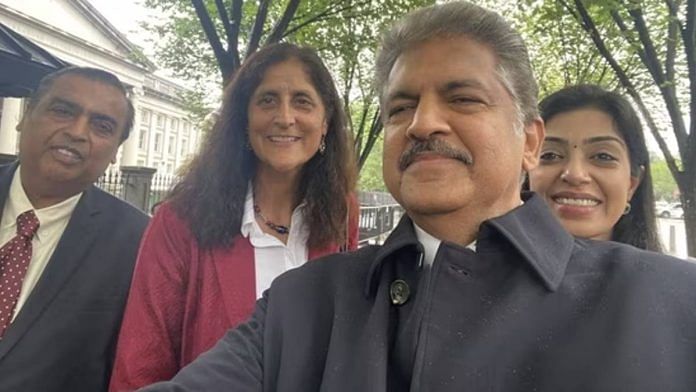Bengaluru: A “million-dollar” selfie clicked by Anand Mahindra last week along with Mukesh Ambani, Sunita Williams and Vrinda Kapoor in Washington DC has taken the internet by storm.
While businessmen Mahindra and Ambani are instantly recognisable for the fortunes they have amassed, and Indian-American astronaut Williams for her spacewalks, Kapoor is the dark horse in the frame.
A deep-tech entrepreneur who maintains a low-profile, she is the CEO of aerospace company 3rdiTech (pronounced third-eye tech), which was incubated in IIT Delhi in 2018 and is part of the Berkeley SkyDeck accelerator programme since 2022.
The company, which manufactures application-specific integrated circuits (ASICs), or customised chips for intelligence, surveillance, and reconnaissance (ISR), has emerged as one of the key players in the aerospace sector after Prime Minister Narendra Modi’s visit to the US last week.
in 2022, 3rdiTech entered into a strategic partnership with US defence major General Atomics Aeronautical Systems (GA-ASI), with the deal being touted as a boost for the Atmanirbhar Bharat campaign.
3RDiTech was one of the inaugural winners of the Ministry of Defence’s flagship iDEX programme’s first edition in 2018.
Kapoor works at the intersection of national security and technology, and has grown prominently in the technology industry in the past few years. Last week, she was a guest along with Mahindra and Ambani at the state dinner hosted by US President Joe Biden for PM Modi in Washington DC.
Following the dinner was an event — India-US Hi-Tech Handshake — where Mahindra, Ambani and Kapoor were present and in conversation with each other as well as US Secretary of Commerce Gina Raimondo. Kapoor was seated next to Microsoft CEO Satya Nadella at this meet.
According to a tweet put out by Mahindra, following the event, he along with Kapoor and Ambani missed the group shuttle bus to their next engagement, and attempted to book an Uber. At that point, they spotted astronaut Williams, with whom they took a selfie.
“I suppose this was what they would call a ‘Washington moment’. After the tech handshake meeting yesterday, Mukesh Ambani, Vrinda Kapoor & I were continuing a conversation with the Secretary of Commerce & missed the group shuttle bus to the next lunch engagement. We were trying to call an Uber when we ran into NASA astronaut Sunita Williams. Time for a selfie & we also asked if we could hitch a ride on her space shuttle instead of an Uber,” Mahindra tweeted, sharing the selfie.
Also Read: From jet engines to drones, space and 6G – Big takeaways from PM Modi’s US visit
What does Kapoor’s company do?
3rdiTech devices are utilised in a variety of applications in the fields of aerospace, automotive and defence, including the military and Indian Space Research Organisation (ISRO).
The circuits include CMOS image sensors made by the company, which create custom cameras that use electro-optical sensing in the near infrared and short-wave infrared wavelengths.
Kapoor’s company is into research & development, and is part of Berkeley SkyDeck accelerator programme, one of US’ top university incubators. In this programme based out of University of California, Berkeley, about 20 start-ups are selected every six months for a $200,000 investment from the Berkeley SkyDeck Fund.
According to reports, Kapoor is a biologist by training, and was invited to the White House as part of a delegation of Indian entrepreneurs who aid in building strategic alliances diplomatically.
She is said to aggressively promote ties between India and other countries in the technology sector, and is especially active in promoting semiconductor technology within the Indian military.
“India’s semiconductor mission must converge with its military ‘Atmanirbhar’ ambitions as a geopolitical priority. The country needs hundreds of chip start-ups to serve its military and commercial needs. India is home to 20 percent of the world’s chip designers, almost all of whom are employed in the back offices of foreign firms. It is time our human talent works to further our national interests,” she wrote for ThePrint last September.
What are CMOS sensors?
CMOS (pronounced sea-moss) stands for complementary metal-oxide semiconductor and is the most widely used semiconductor technology in microchips. It is a type of transistor — metal-oxide-semiconductor field-effect transistor. The technology is used in microchips that make up various devices, including motherboards.
CMOS is also used for analog technology, such as for sensors. CMOS sensors are typically image sensors called active-pixel sensors. The little device that fits in the palm of a human hand consists of a photodetector that detects light, and is used in a wide variety of applications, primarily in digital cameras. Over the last two decades, these sensors were used in other digital devices such as desktop cameras and surveillance cameras.
CMOS sensors enabled extremely quick proliferation of digital camera technologies across the world.
The Indian military, with its flagship programmes like the Defence Research and Development Organisation’s Technology Development Fund (DRDO-TDF) and Innovations for Defence Excellence (iDEX), needs to be stakeholders with the Indian semiconductor mission to create an ecosystem of chip start-ups, Kapoor had stated in ThePrint.
(Edited by Nida Fatima Siddiqui)
Also Read: India has joined the global chip race. Question is, should it fly solo?



